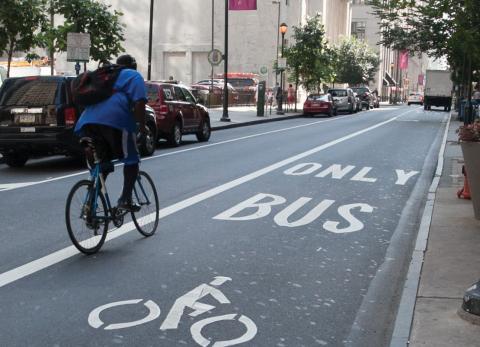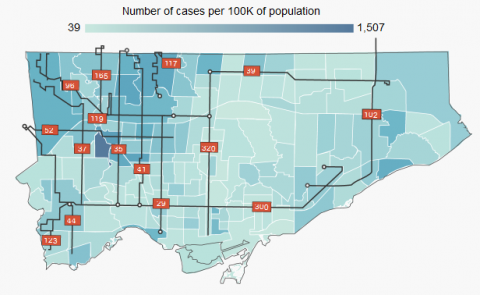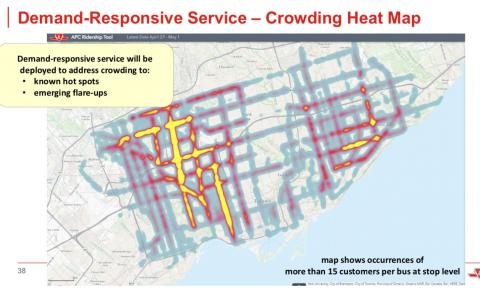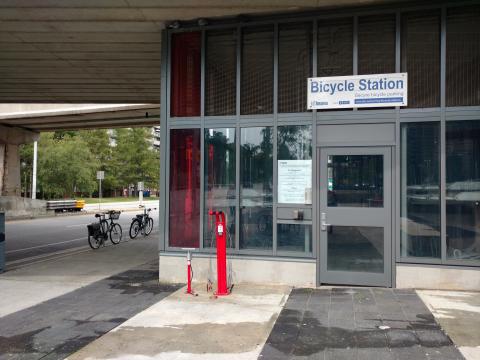
Cycling and transit: complementary forms of mobility
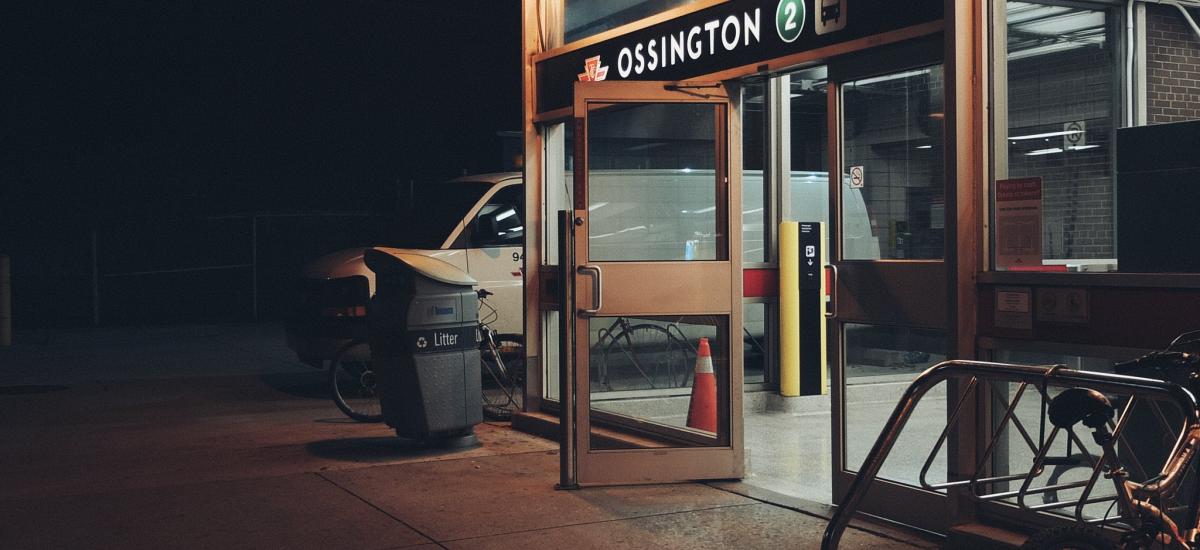
Keep in touch! Sign up for email updates to stay in the loop.
Subscribe to our monthly newsletter: The Ring & Post
The way we get around Toronto has changed a lot during COVID-19: there has been a spike in cycling for transportation and recreation, and there are concerns that as we move into new phases of our pandemic response, residents may avoid transit out of fear of getting sick. Cycling could be a “transit relief valve”, but in many parts of the city, cycling infrastructure is just one of many methods that will be needed to help residents get around by bike.
Lake Shore Boulevard and Bayview Avenue opened up to people walking, cycling, and rolling on weekends, temporary bike lanes are being installed in the core, Scarborough, and North York, and Quiet Streets are being rolled out across the city. These are good additions to our permanent cycling network, but we also need a robust transit system to provide equitable transportation options.
This week, we wrote to the Toronto Transit Commission (TTC) Board to express our support for bus-only lanes, installing cycling infrastructure along with Bus Rapid Transit (BRT) routes, and cautioned against service cuts that could affect the most marginalized communities in Toronto.
Together, riding a bike and taking transit can expand mobility options for more people
Developing permanent and pandemic-responsive transit funding sources will be essential to expanding transportation options for residents across the city. Cycle Toronto has, along with 70 other groups, joined TTC Riders' call for emergency and permanent transit funding. TTC Riders is calling on the City to match the TTC's call to install bus-only lanes for Fall 2020.
| Secured, indoor bicycle parking station at Victoria Park Station. |
Expanding transportation options does not have to be an either/or equation, and the City has recognized this; they built secure bicycle parking at Victoria Park Station and Union Station, increased double-stacked bicycle parking capacity at several stations, such as Bathurst Station, and have provided bicycle repair stands at TTC stations. All of these amenities can make it easier for residents to get around by combining transit and cycling to make their commute more enjoyable, quick, and convenient.
Barriers to combining cycling and taking transit
Many barriers still exist in Toronto that may prevent a resident from choosing to ride a bicycle for transportation including:
- Cost: bicycles, particularly during the pandemic when supply is low, have a higher upfront cost compared to purchasing monthly TTC pases using Presto. Purchasing both a bicycle and paying for transit fare can also be more expensive than doing one or the other. While Bike Share has potential, sporadic locations in the suburbs plus a 30 minute trip limit handcuffs its current effectiveness. Furthermore, the cost of Bike Share memberships, the inability to pay with cash, and the requirement of a credit card to place a deposit can also be a barrier for low-income residents.
- Distance: distances of less than 5 km are considered “generally cyclable” and distances up to 10 km are also manageable, resulting in trips of about 30 minutes. Commuting further distances on a bike can be feasible depending on health, fitness, amenities, and routes.
- Community: building a culture around riding a bike for transportation not just recreation takes time and support, and mode shift doesn’t happen overnight. Bike hubs, such as the model employed by Scarborough Cycles, can lead the charge to transform the culture of cycling in the suburbs.This can be achieved by expanding bike hubs throughout the city.
- Unsafe cycling infrastructure: a lack of protected bike lanes and a connected network of trails, particularly in suburban parts of the city, can prevent residents from cycling.
Opportunities created by cycling and taking transit
Cycling can help bridge some of the gaps created in transit, such as:
- First and last mile trips: cycling for the first and/ or last mile of a trip can eliminate the need for local bus routes, which are typically less frequent and less reliable compared to the subway or streetcar network.
- Expands distance: cycling and taking transit can expand how far someone can go and in a shorter time. This helps bridge gaps in service where the closest station may have been deemed “too far to walk” but is well within cycling distance.
- Enjoyment: even if you’re able to take transit for the entirety of a trip, cycling is fun, great exercise, and good for your mental and physical health.
- Convenience: cycling for a portion of a trip can reduce reliance on transfers and make a commute more convenient.
TTC Bus-Only Lanes
Cycle Toronto supports separated, protected cycle tracks or multi-use paths adjacent to bus corridors. We are interested in exploring solutions to ensure that bus rapid transit (BRT) can be delivered with cycling infrastructure as a pandemic response and recovery solution. We urge the TTC to ensure that inclusion of cycling infrastructure is not delayed until 2024, and to ensure that it can be delivered in tandem with the creation of BRT lanes.
The proposed bus-only lanes on Eglinton Avenue E, Kingston Road, Morningside Avenue, and Ellesmere Road are all indicated in the Cycling Network Plan as being ‘Top Priority Cycling Routes.’
While the proposed bus-only lanes on Eglinton East won’t include bike lanes at the time of installation in Fall 2020, we encourage the TTC to permit bicycles in the bus lanes as a temporary shared bike-bus lane until such a time as the bicycle lanes can be built.
| A shared bus-bike lane on Walnut Street, Philadelphia (credit: Philadelphia Bicycle Coalition, via NACTO). |
We also ask for the TTC’s support on the ActiveTO bike lanes on Overlea approved for consideration at May 28 Council. Unlike the other historic ActiveTO bike lane projects like Dundas, University, Bloor, Brimley, and Danforth, Overlea appears stalled. While Overlea is a high-frequency bus route, the stretch is only 1.8 km and would be a crucial cycling connection for the communities of Thorncliffe and Flemingdon Park.
We continue to urge the city to expand ActiveTO protected temporary bike lanes this year to further build a more equitable network to serve what Mayor John Tory called a “transit relief value”. As part of future recovery and rebuild, we will continue to advocate on these roads for permanent cycling infrastructure, and the report to the TTC Board provided illustrative mockups of what cycling infrastructure could look like.
| Eglinton Ave E - Conceptual Cross-Section for 36-metre right of way (ROW) with a separated bi-directional cycle track. |
Shared bike-bus lanes will not meet the standard of being accessible for all ages and abilities, but as temporary measures to keep people moving could help make these arterials a better option for some people who choose to ride in the short term.
Essential workers continue to commute
The pandemic has revealed deep inequities in Toronto: many of the crowded bus routes overlap with COVID-19 hot spots in the northwestern part of the city. Many of the buses serve industrial areas, where essential workers commute to their jobs, and are identified by the City of Toronto as Neighbourhood Improvement Areas, which are neighbourhoods with below-average incomes and require additional investment to address issues related to poor access to services.
|
COVID-19 hot spots and TTC crowded bus routes (Toronto Star). |
Demand-Responsive Service - Crowding Heat Map (TTC). |
Cycle Toronto sees a huge opportunity in continuing to pair cycling and transit together. The Eglinton West LRT and Finch West LRT both include cycling infrastructure as part of their road rebuilds. We recognize the incredible value of BRT as being another way to get Toronto moving. However, we are concerned that the introduction of BRT bus lanes will result in service cuts. Suburban Toronto has faced significant hurdles to providing transportation options, which makes it challenging for residents to take transit or cycle. We are encouraged by the rapid expansion of ActiveTO and CafeTO and commend Transportation Services for their rapid installation of temporary bike lanes. We look forward to continuing the discussion of how cycling and transit can go together.
If you value the advocacy work Cycle Toronto does, please consider making a donation or becoming a member. Even $10 helps us have a strong voice at City Hall as well as supporting educational outreach, running cycling events, workshops and more.
Header image by Matilde Park.

